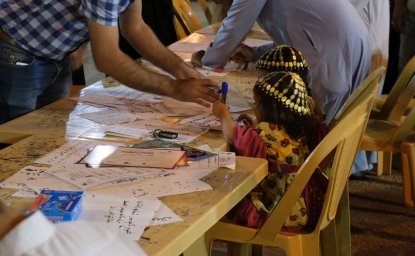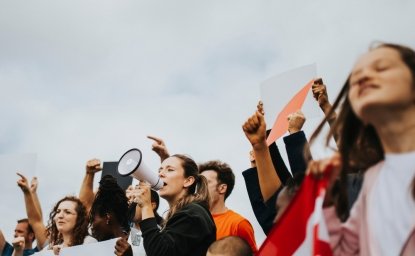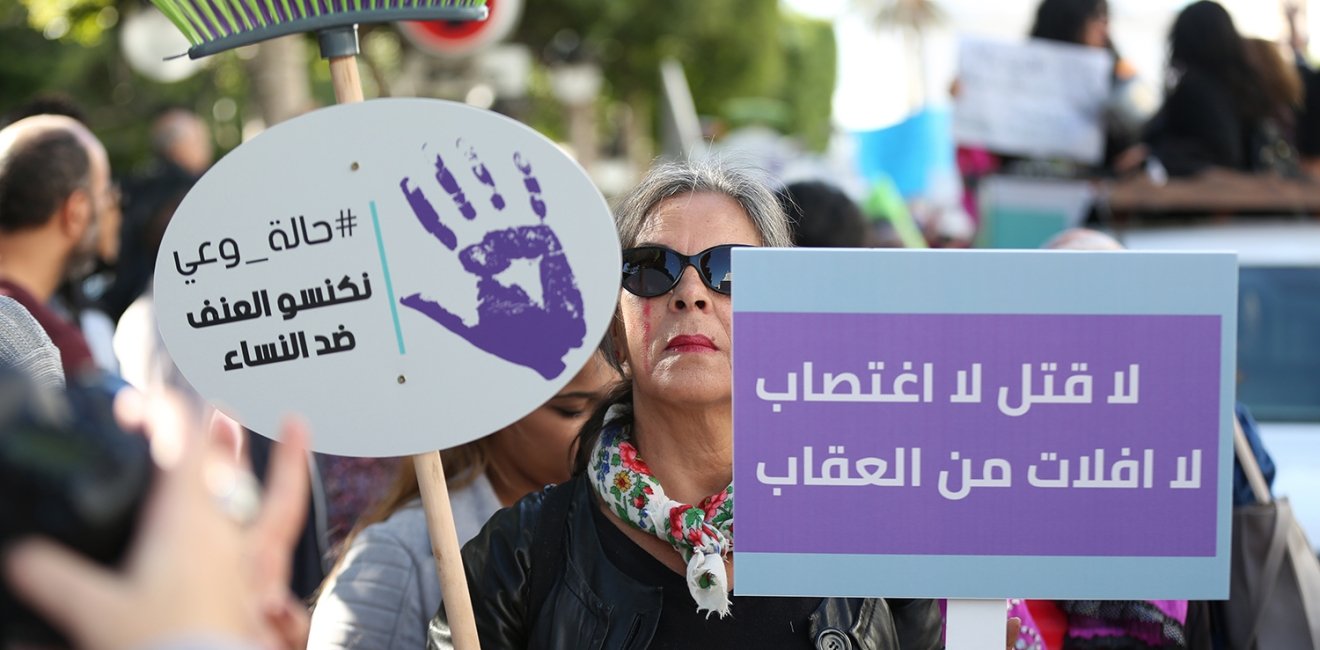
A blog of the Middle East Women's Initiative
In this paper I will examine two studies by Tunisian state institutions on violence against women, one produced before and one after January 2011, to see if the “Arab Spring” brought about changes in this area. And, in this situation, what are the benefits resulting from lifting censorship of the internet and allowing greater access to social media?
The economic difficulties of the family are widespread in Tunisia, resulting in a crisis over the past several decades where the rates of celibacy have risen for both women and men.
In 2010, shortly before the Jasmine Revolution broke out in Tunisia, the Office National de la Famille et de la Population (ONFP) released a study on violence against women. Based on a questionnaire given to 3,873 women aged from 18 to 64, it looked at physical, psychological, sexual, and economic violence. This study found that divorced women were more likely than married women to face a variety of forms of violence, supporting idea of a broad societal rejection of divorced women. It also shows that the frequency of physical and psychological violence is greater when the partner is unemployed. The economic difficulties of the family are widespread in Tunisia, resulting in a crisis over the past several decades where the rates of celibacy have risen for both women and men.
Another important aspect shown in this study is that many women have only their families as a source of support, with non-governmental organizations cited by only 5.4 percent, the police by 3.6 percent, and the healthcare system 2.3 percent of the women questioned. The only associations authorized to work in support of women were those close to the government and, for them, it was important to not “stir up problems.” As for independent associations such as the Association of Tunisian Women for Research and Development (AFTURD) and the Tunisian Association of Democratic Women (ATFD), they faced restrictions on their activities. In addition, neither the police nor the health institutions were prepared for or favorable to accepting the complaints of women.
Political violence is completely absent from this study although women activists, labor union militants, and women working in political and/or research areas faced many difficulties and harassment prior to January 2011, with a number having been imprisoned and sometimes tortured under the regimes of Habib Bourguiba and Ben Ali. The documentary film Apatrides (2014) presents the testimony of a number of these activists.
With the fall of the Ben Ali regime in January 2011, freedom of expression advanced and many independent women’s associations were created throughout the country (prior to 2011 they had been limited to the capital city). Several private television and radio stations were started, and social media multiplied, with one individual able to maintain several Facebook accounts. In 2019 there were 7,300,000 Tunisian Facebook accounts, with 56 percent held by men, 44 percent by women. Many youth also have Facebook pages, with 25 percent of Facebook users aged between 18 and 24, 36 percent between 25 and 34. Also, government departments and ministries have their own Facebook pages which they use to diffuse information.
Sometimes Facebook pages have influenced important government decisions. For example, the circulation on Facebook of a self-portrait by Nadia Jelassi with a ruler measuring her face, after she had been summoned by the state prosecutor and photographed as a criminal for having produced in 2012 an installation showing women in black surrounded by stones, symbolizing their having been stoned, led to great support for the artist. Another example: the support of women generated by Facebook posts for Meriam, a young women raped in 2012 by two on-duty policemen, led to a number of demonstration and marches and helped lead to the policemen’s trial and sentencing to prison terms.
While Facebook has played a role in democratizing freedom of expression, it has also led to abuse in areas that are not covered by legal restrictions. A simple reading of comments related to some online articles testifies to the “cyber violence” or “digital violence” against women, feminists, journalists, and political figures of different orientations, whether secularists or Islamists. Yosra Frawes, president of the ATFD, stated that the “targeting of women who are active on social media ... is not by chance. The lynching of women who express themselves freely on social media, of women activists or women political figures, has the aim of eliminating women from public space.”
In 60 percent of cases they had been compared to an animal.
A study titled “Violence against women in digital space: Facebook as an example,” carried out in 2019 by Sadok Hammami for the Centre de Recherches, d’Etudes, de Documentation et d’Information sur la Femme (CREDIF) considered a sample of 563 individuals and observed interactions on Facebook pages. It found that four of every five women with a Facebook page had been the target of online violence, seven of ten were referred to as “whores” (putes) and 51 percent had experienced insults on Facebook. In 60 percent of cases they had been compared to an animal. The authors of these aggressive words belong to both sexes (70 percent were men) and to all ages. 95 percent of the targets of violence did not bring a complaint; 78 percent live in a state of anxiety, depression, social isolation; 44 percent have discontinued their social media ties.
Unlike the women who responded to the study in 2010 and for whom family was the only source of support, 94 percent of those in the 2019 study did not resort to their families and said they had difficulty communicating with them. The case of the lawyer, Nesrine Garneh (Karneh) who, after protesting the police refusal to hear her client’s complaint, was “mistreated, hit, and sequestered inside a police station ... by the station head and his assistant, while accompanying her client,” will surely further discourage victims from bringing their complaint to the police. It is clear that a number of practices and attitudes concerning violence against women still persist and have not evolved following the “Arab Spring.”
Despite conflicting behavior among the population on these questions, the various actions carried out since 2011 show that we are in the presence of a new generation of feminists, both men and women. For example, the Haute Autorité Indépendante de la Communication Audiovisuelle (HAICA), which is the state institution in charge of the audiovisual sector and was founded in 2013, suspended and fined several television programs on private channels for having justified violence against women and insulted women’s dignity. Also, the association Aswat Nissa (Women’s Voices), founded in 2011, while having some similar perspectives to the independent associations founded during the 1980s, is distinct from them in attempting to be inclusive, welcoming women who wear the hijab and defending sexual minorities. Aswat Nissacontributed to the spread of the Ena Zeda (Me Too) movement, and the association numbers forty thousand subscribers, something unimaginable under the Ben Ali regime.
Political violence, which had formerly been a taboo subject, now appears in the works of artists and activists - both men and women - and in the discourse of state research institutions.
In conclusion, it appears that the “Arab Spring” has given greater visibility to women activists, independent political figures, and to those affiliated with political parties. Political violence, which had formerly been a taboo subject, now appears in the works of artists and activists -- both men and women -- and in the discourse of state research institutions. However, the results of the CREDIF study carried out in 2019 show that much work remains to be done in the struggle to overcome violence against women, and I would recommend that future research, in addition to focusing on men’s violence against women, also address issues such as the violence of women against women and of mothers against daughters. The institutions and associations that have been active following January 2011 appear to provide a new ethical framework for the preservation and promotion of the rights of women.
This blog series is part of the Wilson Center series exploring the many facets of gender-based violence around the world, in parallel with the 16 Days of Activism against Gender-Based Violence that runs from November 25 – December 10, 2020.

Author

Visiting Research Professor, Middle East Institute, National University of Singapore; Former Minister for Women’s Affairs (January to December 2011), Government of Tunisia

Middle East Program
The Wilson Center’s Middle East Program serves as a crucial resource for the policymaking community and beyond, providing analyses and research that helps inform US foreign policymaking, stimulates public debate, and expands knowledge about issues in the wider Middle East and North Africa (MENA) region. Read more


Middle East Women's Initiative
The Middle East Women's Initiative (MEWI) promotes the empowerment of women in the region through an open and inclusive dialogue with women leaders from the Middle East and continuous research. Read more

Explore More in Enheduanna
Browse Enheduanna
How Education Can Empower Young Women in MENA

Empowering the Changemakers of Today: Young Women

Empowering Women to Support Morocco’s Industrial Transformation


